
Shiveluch Volcano Eruption
Kamchatka Peninsula | Eastern Russia
Dates of acquisition:
- April 10th, 2023 | 23:53:05 UTC
- April 11th, 2023 | 23:26:55 UTC
- April 12th, 2023 | 00:41:02 UTC
- April 13th, 2023 | 00:02:29 UTC
- April 14th, 2023 | 00:15:32 UTC
Sensor: Sentinel-2A L2A, Sentinel-3A OLCI, Sentinel-3A,B SLSTR, Sentinel-5P SO2
Coordinates: ca. 56.65°N, 161.36°E
Shiveluch (3,283m) is one of the largest stratovolcanoes of Kamchatka. It is located at the junction of the Kuril-Kamchatka Arc and Aleutian Island Arc, 450 km from Petropavlovsk-Kamchatsky. Its age is estimated at 60 – 70 thousand years. Volcanologists have been expecting an imminent eruption of Shiveluch volcano since the middle of 2022 due to the unstable state of its lava dome. Then, on April 11th, 2023 at 00:54 local time, a strong eruption occurred.
The eruption of Shiveluch and the slightly earlier eruption of Bezymyanny volcano on April 7th occurred almost immediately after the Kamchatka earthquake on April 3rd. This seismic event is thought to have triggered the two eruptions. When the tectonic plates shift, cracks appear in the earth’s crust under the volcano’s crater. The pressure in the crust decreases, causing the magma to rise to the earth surface through these cracks. During the initial paroxysmal phase, the volcano ejects a plume of volcanic gas and ash. As a result of the eruption, the ash plume reached a height of 16 – 17 km, stretched 500 km south-southwest of Shiveluch, reached an area of more than 100,000 km² and continued to spread.
A few days later, on April 12th, another earthquake (magnitude 5.8) was recorded around midnight, with its epicentre in the Pacific Ocean 57 kilometres south of Petropavlovsk-Kamchatsky. Further eruptions followed in the next few days, with the height of the eruption columns reaching more than 10 km. If an ash cloud were to reach a height of 20 kilometers, it could reach the stratosphere, which could have an impact on the global climate. In the stratosphere, volcanic gases such as sulfur dioxide could quickly condense into sulfate aerosols, which would reflect larger parts of the solar radiation back into space and cause short-term cooling. The ashfall in the village of Klyuchi in the Ust-Kamchatsky region caused by the eruption of the Shiveluch volcano was the strongest recorded in the last 60 years. A layer of ash of about 85 mm was measured, and ashfall continued.
Monitoring the volcano was difficult due to bad weather (clouds, snow, and blizzard). The sky was covered with a black cloud within a radius of several tens of kilometres around the volcano. The electrostatic voltage in the ash cloud caused thunder and lightning. On April 14th, the activity of the volcano weakened.






